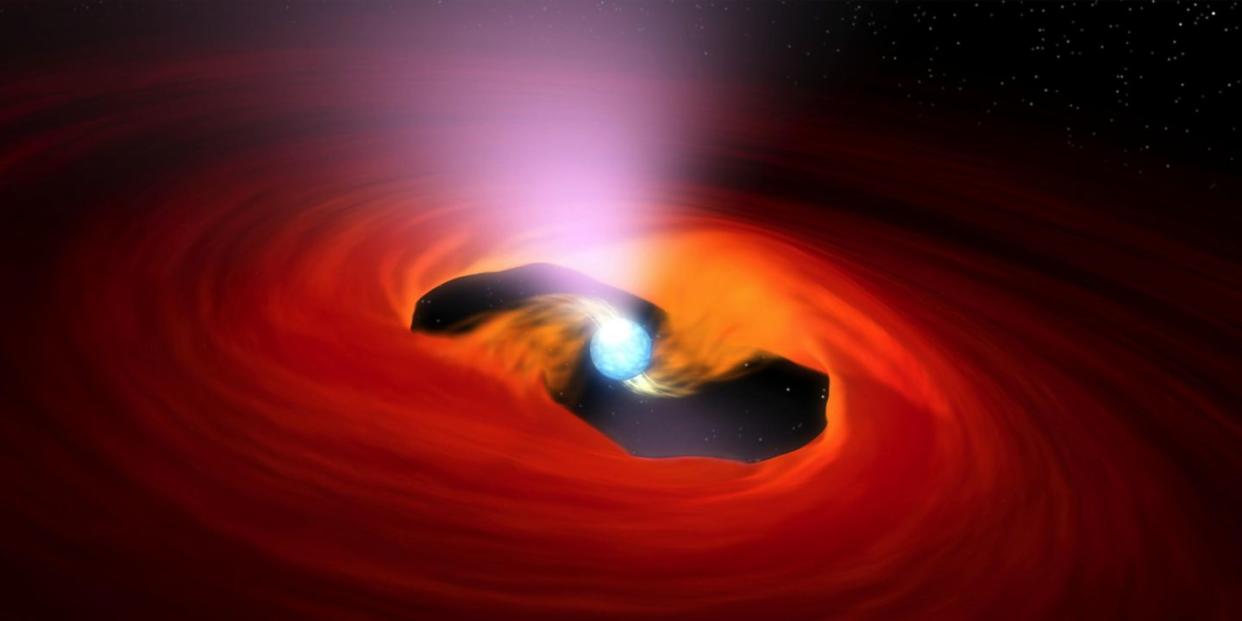Astronomers Just Watched a Dead Star Eat Its Neighbor, Which Is Pretty Sick

Astronomers captured the "power up" sequence of a pulsar right before it gobbled up gas and dust from a nearby star and shot a burst of X-rays into space.
It's the first time they've captured this entire process before.
The research, astronomers say, will help us understand how pulsar outbursts form.
For the first time ever, scientists watched a pulsar "power up" before it gobbled up material from a nearby star and released an outburst of cosmic X-rays thousands of times brighter than the sun.
After a star dies, it either turns into a black hole or neutron star. Pulsars are ultra-dense neutron stars that rotate are regular intervals, emitting light periodically like a lighthouse. Sometimes pulsars are part of what's called an accreting neutron star binary system. They slurp up nearby material—often gas and dust from a neighboring companion star—and subsequently shoot X-rays out into space a few weeks later.
The pulsar in question, SAX J1808.4-3658, spins incredibly quickly, around 401 rotations every second, and is found 11,000 light-years from Earth in the constellation Sagittarius. Like a hungry tiger, SAX J1808.4-3658 circles its companion star every two hours. It took 12 days for that accreted material to swirl inward before the stellar outburst.
“These observations allow us to study the structure of the accretion disk, and determine how quickly and easily material can move inwards to the neutron star,” Adelle Goodwin, a Ph.D. candidate at the Monash School of Physics and Astronomy, said in a press statement. Researchers have never captured the process from start to finish—until now.
Previous studies suggest the star would start acting up. So the scientists pointed seven different instruments—encompassing a wide range of frequencies—at SAX J1808.4-3658, including NASA's Swift X-Ray Observatory and the Nicer Instrument, which is currently strapped to the International Space Station.
“Using multiple telescopes that are sensitive to light in different energies we were able to trace that the initial activity happened near the companion star, in the outer edges of the accretion disk, and it took 12 days for the disk to be brought into the hot state and for material to spiral inward to the neutron star, and X-rays to be produced,” Goodwin said.
The team, which included researchers from New York University Abu Dhabi, also discovered the disk of material was rich in helium. (This is strange, because hydrogen makes up the bulk of most of the accretionary disks that surround pulsars.)
The scientists presented their work Monday at the virtual American Astronomical Society and published it May 6 in the Monthly Notices of the Royal Astronomical Society.
“This work enables us to shed some light on the physics of accreting neutron star systems, and to understand how these explosive outbursts are triggered in the first place, which has puzzled astronomers for a long time,” astrophysicist David Russell, of NYU Abu Dhabi, said in the statement.
You Might Also Like


